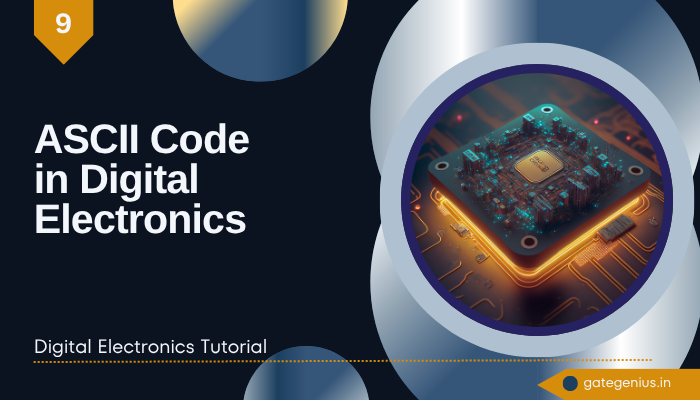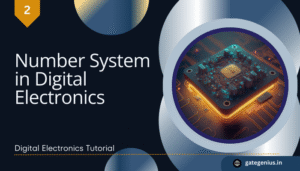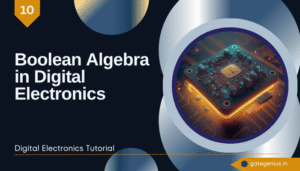In digital electronics, communication between devices and humans often requires representing text characters in binary form. One of the most important codes used for this purpose is the ASCII Code — a standardized character encoding scheme. Understanding ASCII Code in Digital Electronics is essential for designing and working with digital communication systems, microcontrollers, and computer interfaces.
This blog explains what ASCII is, its structure, features, and its role in digital systems.
What is ASCII Code?
ASCII stands for American Standard Code for Information Interchange. It is a character encoding standard used to represent text in computers, communication equipment, and other devices that use text.
ASCII assigns a unique 7-bit binary number to each character, including letters (both uppercase and lowercase), digits, punctuation marks, and control characters.
Why is ASCII Important?
Digital systems process only binary data (0s and 1s). ASCII provides a way to convert readable characters into binary so computers can store, process, and transmit text information efficiently.
ASCII Code Structure
- ASCII uses 7 bits to represent each character, allowing for 128 unique symbols.
- The 7 bits can represent characters numbered 0 to 127.
- An extended ASCII uses 8 bits (1 byte) and can represent 256 characters, adding special symbols and accented letters.
ASCII Code Table (Partial)
| Character | ASCII Code (Decimal) | ASCII Code (Binary) |
|---|---|---|
| A | 65 | 1000001 |
| B | 66 | 1000010 |
| a | 97 | 1100001 |
| b | 98 | 1100010 |
| 0 | 48 | 0110000 |
| 1 | 49 | 0110001 |
| Space | 32 | 0010000 |
| Enter | 13 | 0001101 |
Types of ASCII Characters
1. Control Characters (0–31 and 127)
Control characters are special, non-printing codes used to manage how text and devices behave. They don’t show up as letters or numbers but control things like cursor movement or deleting text.
Examples:
- Carriage Return (CR, ASCII 13): Moves the cursor to the beginning of the line.
- Line Feed (LF, ASCII 10): Moves the cursor down to the next line.
- Backspace (BS, ASCII 8): Deletes the character before the cursor.
- Delete (DEL, ASCII 127): Erases a character, often used for corrections.
These codes are important for formatting text and controlling devices like printers and terminals.
2. Printable Characters (32–126)
Printable characters are all the symbols, letters, and numbers you see on your screen or type on a keyboard. They include:
- Space (ASCII 32): The blank space between words.
- Digits (0-9, ASCII 48–57): Numbers like 0, 1, 2, … 9.
- Uppercase letters (A-Z, ASCII 65–90): Letters like A, B, C, … Z.
- Lowercase letters (a-z, ASCII 97–122): Letters like a, b, c, … z.
- Punctuation and symbols:
- Comma (
,ASCII 44) - Period (
.ASCII 46) - Question mark (
?ASCII 63) - Dollar sign (
$ASCII 36) - At symbol (
@ASCII 64)
- Comma (
How ASCII Works in Digital Electronics
- Each character typed on a keyboard is converted into its ASCII binary equivalent.
- This binary code is then transmitted or processed by digital circuits and microprocessors.
- Devices like displays, printers, and communication interfaces decode ASCII to show readable text.
Advantages of ASCII Code
1. Standardized
ASCII is a universally accepted standard for representing text characters in digital systems. This standardization ensures that different devices, software, and communication protocols interpret text data consistently. Whether you send an email, store a file, or display a message on a screen, ASCII provides a common language that all digital systems understand, making data exchange reliable and seamless worldwide.
2. Simple
The ASCII code is straightforward and easy to implement. Each character is represented by a unique 7-bit binary number, which makes encoding and decoding processes simple and efficient. This simplicity helps reduce errors in data transmission and makes it easier for hardware designers and programmers to work with text data, speeding up development and improving system reliability.
3. Compact
ASCII uses only 7 bits to represent each character, which makes it memory-efficient compared to some other encoding systems that use more bits per character. This compactness reduces the amount of storage and bandwidth needed for text data. In many systems, ASCII characters are stored in an 8-bit byte with an extra parity bit for error detection, further enhancing data integrity. The ASCII code in digital electronics is thus well-suited for resource-limited devices and communication channels where efficiency is critical.
4. Compatible
Because ASCII has been around for decades, it is compatible with almost all hardware, software, and communication protocols. This wide compatibility ensures that ASCII-encoded data can be easily exchanged between different platforms and devices without needing conversion. This makes ASCII a reliable choice for digital communication, data storage, and user interfaces in countless electronic systems.
Disadvantages of ASCII Code
1. Limited Character Set
The original ASCII code supports only 128 characters, which include basic English letters, digits, and some control characters. This limitation makes it insufficient for representing characters from other languages, such as accented letters in European languages or entirely different scripts like Chinese, Arabic, or Hindi. As a result, ASCII cannot handle global text communication on its own.
2. No Support for Graphics or Complex Symbols
ASCII was designed primarily for text and simple control instructions, so it does not include graphical characters or complex symbols needed in modern computing. Characters like emojis, mathematical symbols, or special icons are outside the ASCII range, requiring other encoding systems like Unicode to represent them properly.
3. Compatibility Issues with Extended ASCII
To overcome the limited character set, various versions of Extended ASCII were created by adding extra characters (up to 256), but these extensions are not standardized globally. Different systems use different versions of Extended ASCII, which can lead to compatibility problems when sharing text files or data between platforms. This inconsistency poses challenges in seamless communication. In many devices and applications, the ASCII code in digital electronics still remains the foundation, but reliance on extended sets requires careful handling to avoid errors.
4. Inefficient for Multilingual Text
Because ASCII cannot represent non-English alphabets, systems that need to handle multiple languages often require larger encoding schemes like UTF-8 or UTF-16. These encodings increase complexity and data size but are necessary for global communication, limiting ASCII’s usefulness in multilingual environments.
5. Outdated for Modern Applications
With the rise of the internet and global connectivity, ASCII’s limitations make it less suitable for modern applications that demand rich text, internationalization, and multimedia content. While still foundational, ASCII alone cannot meet the needs of today’s diverse digital ecosystems.
Applications of ASCII Code
1. Text Communication Protocols
ASCII is widely used in text-based communication protocols such as email, serial communication, and network messaging. These protocols rely on ASCII’s standardized character set to encode and transmit readable text data between devices. Because ASCII is simple and compact, it helps ensure messages are sent and received accurately, making it ideal for these communication methods.
2. Computer Keyboards and Displays
Every keystroke on a computer keyboard is translated into its ASCII binary code before being processed by the computer. Similarly, computer monitors and display devices decode ASCII codes to show characters on the screen. This makes ASCII essential for the basic input and output operations of digital electronics systems.
3. Programming Languages and Compilers
Most programming languages use ASCII characters to write code, including keywords, variables, and symbols. Compilers and interpreters recognize ASCII codes to parse and execute programs correctly. The ASCII code in digital electronics provides a universal set of characters that programming tools rely on, ensuring consistent code representation across different development environments.
4. Data Storage and File Formats
ASCII is the foundation for many simple data storage formats, like plain text files (.txt). These files store characters using ASCII codes, making them lightweight and easily readable by both humans and machines. ASCII encoding ensures that text stored in files can be opened and interpreted correctly by different software applications without compatibility issues.
5. Embedded Systems and Microcontroller Interfaces
In embedded electronics, microcontrollers often use ASCII codes to communicate with sensors, displays, and other devices. ASCII provides a simple and efficient way to send commands and receive data in text form, enabling easy debugging and control of hardware components.
6. Network Protocols and Internet Services
Many internet protocols, such as HTTP and SMTP, use ASCII characters to format commands and data exchanges. This helps maintain clear and standardized communication between servers, browsers, and email clients, enabling the smooth functioning of web and email services worldwide.
7. Debugging and Diagnostic Tools
ASCII codes are widely used in debugging tools and diagnostic messages in digital electronics. Engineers and developers use ASCII-encoded text to read error logs, status updates, and system messages, making troubleshooting more efficient and accessible.
Frequently Asked Questions?
Q1. How many bits does ASCII use?
A1. Standard ASCII uses 7 bits, while extended ASCII uses 8 bits.
Q2. Can ASCII represent non-English characters?
A2. Standard ASCII cannot; extended ASCII includes some additional characters but is still limited for global languages.
Q3. Why is ASCII still important today?
A3. Because it remains the foundation for text encoding in computers and communication.
Q4. What is the difference between ASCII and Unicode?
A4. Unicode supports a much larger range of characters and symbols from multiple languages, while ASCII is limited to 128 characters.
Conclusion
ASCII Code is fundamental in digital electronics for representing characters in a machine-readable binary format. Its simplicity, efficiency, and universal acceptance have made it a cornerstone of digital communication and text processing across various devices and systems. From keyboards and displays to programming languages and communication protocols, the ASCII code in digital electronics enables seamless interaction between humans and machines.
I hope you understand the ASCII Code in Digital Electronics. So don’t forget to share this post with friends and anyone preparing for the GATE, UGC NET exams, or studying at the university.



